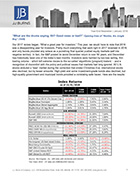“Yes we can can, why can’t we? / If we wanna get together we can work it out.” The Pointer Sisters, “Yes We Can Can”
Global securities markets continued their buoyant recovery from the COVID bear market in the third quarter of 2020. Returns in all major asset classes were positive for the third quarter and reflected increasing confidence in the search for a vaccine and a return to an economic ‘normal’ in 2021, possibly sooner.
Risk assets – equities, high-yield bonds and real estate – posted another quarter of good returns, but in more muted tones that in Q2. Large-cap earnings reports generally came in better than expected, but there were some small hurdles to show an earnings ‘beat.’ International stocks also did well, particularly in the emerging markets (EM) regions, which are dominated by Asian stocks. In fact, EM stocks doubled the returns of U.S. small-cap stocks in Q3 and are ahead YTD through quarter end. Oil prices continue to struggle due to uncertain demand going forward. Real estate also suffers from this uncertainty, as changing habits due to coronavirus may affect malls, retail stores and office space.
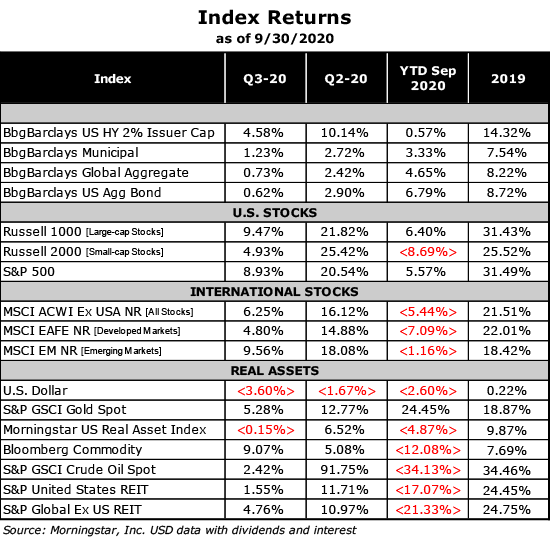
“You gotta free me / ‘Cause I can’t give the best / Unless I got room to move.” John Mayall & the Bluesbreakers, “Room to Move”
Despite some of the excellent market results detailed above, we firmly believe that how nations grapple with the economic and medical effects of COVID will determine the longer-term strength of the recovery. This implies that (1) the stock market is NOT the economy, and (2) the virus ‘cure’ and the return to a form of economic normal are not imminent. Data indicates that we are in fact entering a second wave of the pandemic, as quarantine fatigue, relaxed social behaviors and school re-openings have presented new challenges. These changes are evident in the data below, which show rising cases on the left and fatality increases on the right. The good news around these numbers is that the treatment protocols for the virus appear to becoming more effective as time passes.
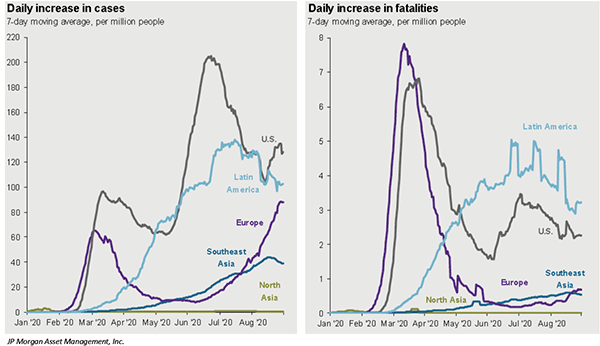
We can extrapolate that some of the increase in these cases has occurred due to increasing global mobility, which recovered fairly quickly, as demonstrated below:
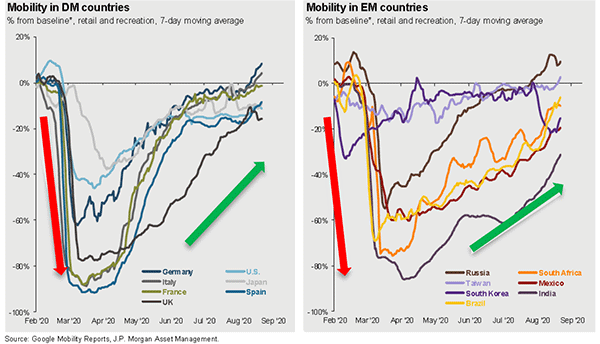
It’s generally assumed that vaccine research and production are moving rapidly, and it’s important to note that we must inoculate the world population with an effective vaccine. This implies a valid, large-sample test and an effective production-and-distribution protocol as well. Ultimate widespread distribution may not occur until sometime in the latter half of 2020.
“The battle outside ragin’ / Will soon shake your windows / And rattle your walls / For the times they are a-changin'” Bob Dylan, “The Times They Are A-Changin’”
Understandably, in this confusing and difficult time, the world is very focused on the American elections in November. History reveals that there has often been market volatility in the few months before an election, but we think the good news for investors is that over the long term, a president’s policies don’t seem to have much effect on the returns in the stock market.
Divided government is the broad historical norm, and some average returns for each of the two-party composites are on this chart:
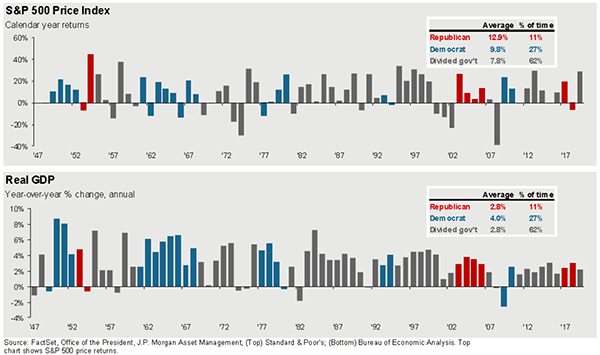
We can see that the average annual return for the S&P 500 price index is 7.8% for the divided government, the dominant format, with average Real GDP growth of 2.8%. We can also see that the market posted positive returns more often than negative results. The same conclusion can be drawn from the GDP data in the bottom chart. This data deflates beliefs that particular polices of a single party will always result in better equity returns or GDP growth.
“I’ll go back working, I gotta buy my kids a brand new pair of shoes / I drink a little beer in a tavern / Cry a little bit of these working man blues” Merle Haggard, “Workin’ Man Blues”
The top requirement for an economic rebound is the classic promise of every politician: jobs. As we can see below, millions of jobs have been lost and regained through the pandemic crisis thus far. The leisure and hospitality and transportation industries have clearly been the hardest hit. As we move into colder weather without a proven vaccine, headlines report increasing permanent layoffs in a variety of industries. While job losses are a feature of every recession, many expected that government assistance and a short shutdown period would promote an equally sharp rebound. As time passes, we are not as sanguine about a recovery without more jobs, which promote the economic growth, productivity gains and inflation the global economy needs to recover and move into a new growth phase.
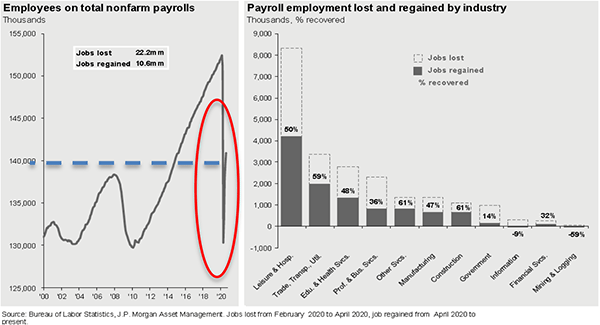
“Standing tough under stars and stripes / We can tell / This dream’s in sight / You’ve got to admit it / At this point in time that it’s clear /The future looks bright” Donald Fagen, “I.G.Y.”
As we look forward almost a year into the pandemic crisis (while falling back into a ‘second wave’), and cognizant of the U.S. elections just a few weeks away, we’ve prepared this broad outlook for the near- and intermediate-term future:
- Pretty much everything depends on how we manage the pandemic, both here and abroad.
- We agree with Fed Chair Powell that more short-term fiscal stimulus is absolutely necessary.
- Interest rates are expected to stay low for at least 3 more years, but credit quality and selection are very important to good results.
- Companies MUST have access to capital in private and public markets to survive.
- Stocks look more attractive in this environment, as a portfolio composed of only bonds at current yield levels won’t be sufficient for long-term growth.
- S. large-cap stocks and growth stocks (the classification for many technology names) may be a good investment for the intermediate term.
- Valuations are challenged in some regions and some parts of the market-cap spectrum.
Our long-term optimism has not changed. We are firm believers in the adaptive ability of the U.S. economy, and see growth ahead. The path forward will not always be smooth, and investors should expect additional market gyrations as we move toward and beyond the election. The impending election is not the main reason to buy or sell stocks. In the end, it is the health of the economy, management decisions of companies and ultimately corporate profits that determine if stock prices move higher or lower. We see long-term opportunities ahead that could be punctuated in the short-term by extreme market movements. Investors tend to make long-term decisions while relying on news of the moment. Your portfolio asset allocation should be based upon your needs over the next ten years, not the next ten months. This is the key to successful long-term investing, and we will continue to manage your portfolio with this philosophy in mind.
Please take the time to think about your future and to contact us with your comments and questions so that we may put our knowledge and experience to work for you.
—Your Wealth Management Team at JJ Burns & Company
Download Market Commentary
Disclosure: J.J. Burns & Company, LLC is a registered investment adviser with the U.S. Securities & Exchange Commission and maintains notice filings with the States of New York, Florida Pennsylvania, New Jersey, Connecticut, Georgia, Illinois, North Carolina, and California. J.J. Burns & Company, LLC only transacts business in states where it is properly registered, or excluded or exempted from registration. Follow-up and individualized responses to persons that involves either the effecting or attempting to effect transactions in securities, or the rendering of personalized investment advice for compensation, as the case may be, will not be made absent compliance with state investment adviser and investment adviser representative registration requirements, or an applicable exemption or exclusion.
All investing involves risk, including the potential for loss of principal. There is no guarantee that any investment plan or strategy will be successful.
The foregoing content reflects the opinions of J.J. Burns & Company, LLC and is subject to change at any time without notice. Content provided herein is for informational purposes only and should not be used or construed as investment advice or a recommendation regarding the purchase or sale of any security. There is no guarantee that the statements, opinions or forecasts provided herein will prove to be correct.
Past performance may not be indicative of future results. Indices are not available for direct investment. Any investor who attempts to mimic the performance of an index would incur fees and expenses which would reduce returns.
Securities investing involves risk, including the potential for loss of principal. There is no assurance that any investment plan or strategy will be successful.


